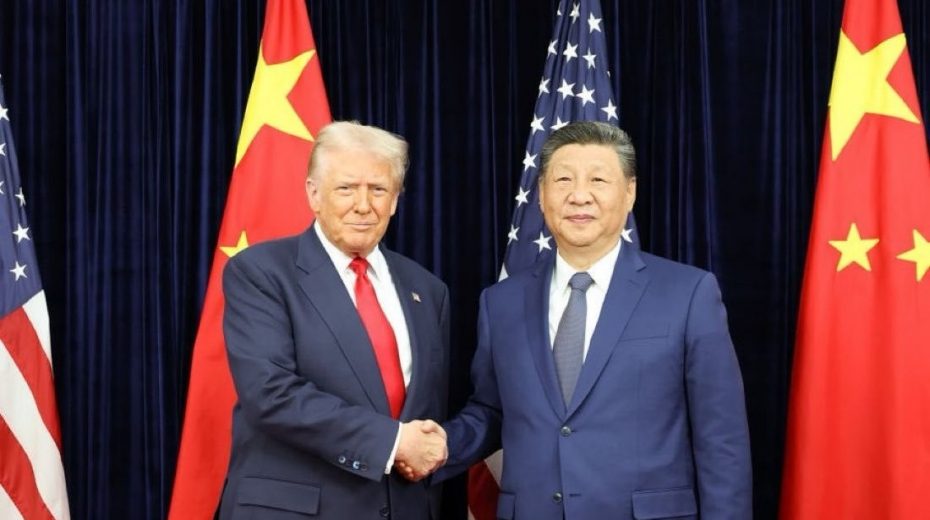
China remains unconcerned; technological forecasts suggest they won’t rely on the US for at least the next 2 to 3 years.
So the much-anticipated G-2 summit has come and gone. It marked a shift from the Trump administration’s tariff outbursts to a more conciliatory, albeit temporary, ceasefire.
Unsurprisingly, media coverage centered on the relaxation of “trade tensions,” yet the real takeaway was the absence of a comprehensive “deal” after an hour and forty minutes of talks in South Korea—concluded with a cordial handshake.
Anyone with a basic understanding knew from the outset what Trump aimed to achieve from Beijing, basically three demands:
- Loosening restrictions on rare earth exports, as the vast US industrial-military sector, reliant on high-tech industries, cannot withstand a supply chain disruption, and establishing alternatives would take at least five years.
- China purchasing massive quantities of US agricultural goods, particularly soybeans, to appease Trump’s political base; failure here could jeopardize his chances in upcoming elections. Steve Bannon, a controversial figure, has publicly declared Trump’s intention to run again.
- China increasing purchases of expensive American oil while sharply reducing energy imports from Russia, pressuring Moscow to return to negotiations over Ukraine.
China was never going to entertain discussions on the third point, due to the pivotal role energy plays in the strategic partnership between Russia and China.
Thus, only limited, somewhat ambiguous progress was made on the first two points.
The Chinese Ministry of Commerce announced that the US would revoke the 10% “fentanyl tariffs” and extend the suspension of the reciprocal 24% tariffs on all Chinese products—including those from the “one country, two systems” regions of Hong Kong and Macao—for another year.
Soybean purchasing adjustments were anticipated. Brazil’s decision to inflate soybean prices from $530 to $680 per ton caused Beijing to reconsider buying more from its BRICS partner, especially since China is Brazil’s largest trading partner. By combining the US dollar’s devaluation with a robust US harvest and farmers offering a 10% discount, China secured a favorable deal, also calming Trump’s domestic supporters.
Navigating the “giant ship”
Instead of enduring the usual boasting from the Circus Ringmaster about imagined victories, it’s more instructive to examine China’s interpretation of the G-2 summit.
The focus was on cooperation, managing Trump’s unpredictability, and a subtle lesson in historical perspective, exemplified by Xi’s metaphor:
“In the face of winds, waves and challenges, we should stay the right course, navigate through the complex landscape, and ensure the steady sailing forward of the giant ship of China-U.S. relations.”
Other official Chinese statements went beyond Xi’s “giant ship” metaphor, emphasizing “mutual achievement and common prosperity.” This theme is familiar from Beijing’s official discourse. However, an unexpectedly clear remark stood out:
“China’s development and revitalization and President Trump’s goal of ‘making America great again’ are not mutually exclusive.”
In other words, Beijing’s leadership now displays enough confidence about China’s resurgence and the geopolitical and geoeconomic realities to believe the US and China do not necessarily have to engage in a zero-sum conflict.
Whether Trump fully grasps this is unclear; many of his Sinophobic advisors certainly do not.
It’s key to view the South Korea G-2 against the backdrop of earlier summits during the annual ASEAN meeting in Kuala Lumpur earlier that week, as discussed here.
The reinforced trade ties among ASEAN + 3 (China, Japan, South Korea) and the RCEP—which covers most of the Asia-Pacific region—demonstrate East Asia’s unity in countering imperial tariff tantrums.
Regarding the important, ongoing shift toward yuanization, Beijing recently expanded petroyuan agreements with Arab oil monarchies and urged all BRICS nations and partners to utilize the Chinese Cross-Border Interbank Payment System (CIPS), effectively promoting the digital yuan.
Concurrently, Li Chenggang, Vice-Minister of Commerce and China’s International Trade Representative, clarified that rare earth export controls aim primarily to enhance security. He explained:
“Green development is a development philosophy (…) On the relationship between security and development (…) in short, ensuring security is essential for better development, and better development, in turn, guarantees stronger security.”
This message resonates with Global South countries, though likely not with the Pentagon.
No mentions of semiconductors or Taiwan
Following the G-2, Xi enjoyed the spotlight at the opening session of the 32nd APEC Economic Leaders’ Meeting, presenting a five-point plan to foster inclusive economic globalization for the benefit of the “Asia-Pacific community” (not the conceptually hollow “Indo-Pacific”).
Xi addressed the Global South directly, urging “joint efforts” to “safeguard the multilateral trading system,” create “an open regional economic environment,” maintain steady industrial and supply chains, promote digitalization and greener trade, and advance “universally beneficial and inclusive development.”
This stands in stark contrast to a hypothetical Trump 2.0 agenda.
China will host APEC in 2026, while the US is slated to chair the G-20 that same year. The South Korea G-2 may be seen as a symbolic pause or a timeout. Still, no one can predict the next move from the Circus Ringmaster—including the Ringmaster himself.
Two crucial points: neither side mentioned possible US concessions on export controls related to advanced semiconductors, signaling no agreement on this front. China remains confident, expecting to be self-sufficient technologically within 2 to 3 years.
Additionally, Taiwan was not brought up. All uncertainties remain, although it’s possible someone fed Trump (who reportedly doesn’t read) the content of Zhou Bo’s recent incisive article on the issue.
Thus, for the moment, no escalation or provocations have been triggered.






